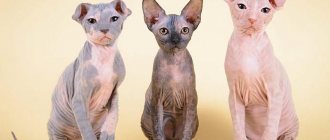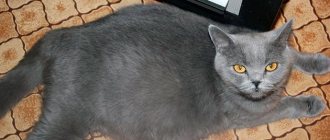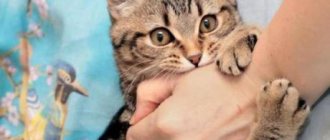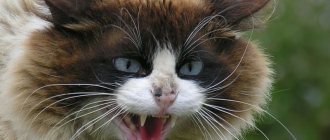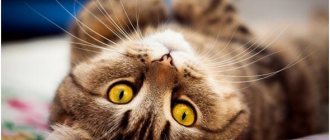The Chantilly Tiffany cat breed can be considered not even rare, but rather endangered. There is very little of this population left, but thanks to the efforts of breeders, these representatives still exist. Kitties have an attractive appearance. Thanks to their rich fur, they look like a plush toy. And by nature they are not capricious, balanced and positive.
In the photo the representative is long-haired Tiffany
Breed Features
This is a rare breed, but popular among cat lovers who prefer animals with beautiful long hair. Chantilly Tiffany has a flexible, slender body covered in chocolate-colored fur. The coat goes down in waves and elegantly frames the neck and ears, creating a fluffy tail. Cats have a wedge-shaped head with soft features and a wide muzzle.
Expressive oval eyes are widely spaced and attract with their amber color. Animals' ears are small in size, rounded at the tips. As for the colors, variations are possible, although at first a dark brown tone was allowed. Now you can find several colors: chocolate, blue, lilac, fawn and synamon.
Colors can be solid, spotted, striped, tabby and mackerel.
The nuances of buying Chantilly-Tiffany kittens
If you become interested in the breed and decide to buy a Chantilly-Tiffany kitten, be prepared for difficulties. There is not a single nursery in Russia where these rare cats are bred. And in foreign countries there are plenty of them. Therefore, be careful with “unscrupulous” breeders who are trying to sell you purebred, as they claim, Chantilly without registration documents, justifying the lack of time for paperwork with their registration.
In the overwhelming majority of such transactions, buyers, instead of the promised Chantilly-Tiffany, which is quite difficult to buy in Russia, purchase a simple mongrel cat, similar in appearance to a purebred animal. Taking into account the small number of rare breeds, it is better to book kittens in a trusted official nursery, even if you have to go a long way to get them or order expensive home delivery of animals.
Standards
Chantilly Tiffany can be considered a large pet, reaching 7 - 8 kg in weight. Description of a cat of this breed, according to the standard:
| Body | Medium to large, muscular, with heavy bones. Strong chest, round in shape (when viewed in profile). The back is straight throughout. |
| Legs | Short limbs, but look proportional. The paws are round, compact, graceful. |
| Tail | Without bends, medium length. |
| Head | Wedge-shaped, with smooth contours, high cheekbones, protruding forward. In profile, the muzzle has a clearly visible curve. The lower jaw is more developed, but not massive. |
| Ears | Wide apart, slightly tilted forward. Wide at the base, pointed at the tips (small tassels and brushes in the ears are acceptable). |
| Eyes | Large, expressive, widely set. They are round at the bottom and oriental at the top. The outer tips of the eyes are slanted towards the ears. The color of the iris is all shades of yellow, with possible green. |
| Coat | Long or semi-long. The fur is soft and silky to the touch, without undercoat. The hair is dense, along the spinal column it fits tightly to the body and is more refined, with a glossy sheen. There is a kind of plume on the tail. It’s good if you have short pants, a collar and ruffles. Different colors are acceptable. Chocolate is considered the most valuable. |
Main characteristics
Representatives of the breed are characterized by a muscular body with slight elongation, as well as lush, silky fur. The presence of undercoat is not provided, so the appearance of tangles is excluded. Because of this advantage, the coat never loses its natural structure and remains silky.
The external properties of the rock are as follows:
- At the end of the body there is a bushy tail, the length of which is comparable to the length of the entire body. The ears are set wide apart and covered with dense hair. And the main decoration of the cute creatures is the fluffy collar that frames the entire neck.
- The cat's muzzle is quite wide, but the presence of a collar slightly softens the contours.
- The head is characteristically wedge-shaped.
- The eyes are oval in shape and come in a variety of shades of yellow, amber or gold. They are clearly expressed against the background of the coat, especially if the coat is dark. In the recent past, the standard allowed only chocolate brown colors, but nowadays any coat color is possible.
- The weight of an adult cat exceeds 5 kg.
Story
Externally unique cats Tiffany Chantilly
Initially, such cats were called “foreign longhaired”. The origin of the genus is unknown, but it is known that the descendants were long-haired Asians and Burmese cats.
The history of the breed began when in 1967 a certain Jenny Robinson bought two chocolate-colored cats (nicknames: Shirley and Thomas). The breeder immediately realized the uniqueness of the acquisition and began breeding the breed. She was helped by felinologist Sinjin Lund, who was closely involved in breeding the Burmese variety. Lund brought several of these wards to an exhibition in New York. The cats were rated highly, but they did not like the name of the breed. In addition, the animals looked very similar to Burmans.
For a long period things did not improve. Kittens appeared, but the breed was not officially recognized until the 90s. Only when other breeders from Canada made some adjustments (Somali cats, Turkish Angoras, Nibelungs and Havana Browns were involved in breeding) was the breed recognized. However, it was renamed Chantilly Tiffany.
Gradually, the number of nurseries decreased, rather than increased, as is customary when a new breed appears. The last one in North America burned down in 2011. All the animals living in it also died. Only one representative of the breed remained alive - Frosty. He gave birth to the cat Acey.
Chantilly Tiffany Babies
Now there are no specialized nurseries, but Tiffany can be purchased from private breeders.
Cost of cats of this breed
Like many other purebred cats, this species is very rare. Naturally, the cost of such a miracle will be extremely high. In order to purchase a kitten of this breed you will have to shell out about $500. There are many factors that can ultimately affect the final cost. These include age, gender, pedigree, and others.
As for finding a pet of this breed, it’s not so simple. At the moment, the number of nurseries around the world that breed this breed is extremely small. As for the CIS countries, they are not here at all. That is why, in order to purchase a purebred kitten, you will have to go to distant Great Britain in search of one. This is the best case scenario. At worst, to another continent altogether, for example, to the USA. There are much more chances of finding what you want.
Colors
At the beginning of their development, Tiffany cats were exclusively chocolate in color. The following colors are acceptable as standard:
- dove-blue;
- lilac;
- beige;
- cinnamon.
Some representatives have fur decorated with a tabby mackerel pattern.
Tiffany Chantilly with popular colors
Description of character
Despite her balance, independence and complaisance, Chantilly Tiffany cannot be classified as a pet that constantly reclines on the sofa. They are very active and playful, although the activity does not last long. Cats observe moderation in everything.
This is truly an ideal pet, suitable for keeping in an apartment. The cat chooses a leader for itself in the form of an owner, to whom it will be devoted. However, she will not impose herself and demand increased attention.
He will just sit next to him and watch.
Such cats find it difficult to tolerate loneliness and neglect. Children are treated well, but they will not take part in their active games.
It’s better for them to hide somewhere so that the kids don’t hit them in their excitement. Other pets are treated tolerantly. By nature, Chantilly is not demanding, quiet, pliable. They love their owner, never show aggression, and are easy to train. They treat strangers with extreme caution and distrust.
Character and behavior
A furry weasel is what breeders kindly call Chantilly Tiffany. This breed is ideal for indoor keeping. Once in your house, the animal will quickly choose one person - its favorite one - and will constantly follow him like a little dog, waking him up in the morning and waiting near the front door after work. And, by the way, under the toilet door too.
It is communication with a person that Chantilly gives preference to. They are soft and reserved, are not afraid of strangers, willingly go to meet guests, but do not allow liberties with themselves. They are easily frightened: if a guest makes a sharp gesture or raises his voice, they quickly retreat to a secluded corner and watch the further development of events from there.
Restraint is another of their distinguishing features, but they also do not shy away from games. Especially if their beloved owner or other pets (with which, by the way, these cats get along very well) will participate.
Chantillies are smart and grasp information on the fly, so they are easy to teach tricks and commands. They look at new objects with interest, and if the owner teaches them through play, then the process will be fun and easy.
They quickly adapt to new places and conditions. But they cannot stand loneliness. This is a real punishment for them! If Chantilly is left alone often and for a long time, she will get sick more often and gradually turn into a real savage.
The cat loves to walk in the fresh air, but letting her go out on her own is very dangerous. A friendly Chantilly Tiffany can be suitable for acquaintance not only with a cat, but also with a dog that can show aggression.
And there are many other dangers lurking for a cat: cars, poisons, and cold. And fleas and ticks brought into the house are unlikely to bring you much joy.
Chantilly Tiffany are more talkers than silent ones. If you prefer quiet, they are not for you.
Chantilly - especially at a young age - are very curious creatures. By trying to stick their nose into all the corners and pots, kids can get an electric shock, burn or other injury, so take precautions in advance: hide all wires away, put special nets on the windows, remove toxic plants, sharp and breakable objects.
How to care
Before you bring your new arrival into the house, you should prepare everything. They purchase the necessary accessories: a bed, a scratching post, a toilet tray, bowls for food and water, toys, everything for hygiene.
Bathing
Chantilly Tiffany is not particularly enthusiastic about bathing, so this procedure is often not resorted to. Once every 2-3 months will be enough. If the wool becomes very dirty, wash it more often. For bathing, pour warm water into a basin (38 - 39 degrees). They place the pet there so that the level reaches the chest. You should only use special hygiene products that are sold in pet stores. In between wet washes, you can use dry shampoo. It is applied to the cover and combed out thoroughly. This can be done daily.
Long-haired dogs need proper care
Wool
Initially, it may seem that Chantilly Tiffany wool needs scrupulous care, but this is a mistaken opinion. Since there is no undercoat, the hair does not get tangled or tangled. True, during molting, the fur thins out intensively - this requires frequent cleaning of the house.
It is necessary to comb the cat every 2 days, and when shedding, twice a day. They use a special comb with rubber teeth, a furminator, a spray antistatic agent and a wool restorer. The first step is to spray the hair with a spray to soften the fur and prevent static. Next, the cover is leveled with a comb. The Furminator is used once a week, and during molting - up to 5 times. Then they go over the fur with a combination brush, and then with a rubber one. The final touch will be spraying a restorative spray.
Ears
An animal's ears need to be cleaned once every 7-8 days. You will need special drops, lotion and sponges (cotton swabs). First, instill drops into the ear (the dosage is indicated on the package).
Next, do a light massage at the base, lasting a couple of minutes. Then moisten the sponge in lotion and place it in the ear. Massage the ear again and remove the tampon. Wipe the inner surface of the ear with a dry cloth.
Teeth
Teeth are also examined and cleaned. The procedure is carried out once every 3-4 days. To do this, purchase a brush and paste from a specialized store. Cleans teeth without much effort.
Brushes for cleaning teeth
Eyes
Clean your eyes every day. To do this, use zoo lotion and napkins. The latter are soaked in liquid, then the eyes are wiped from the inner edge to the outer.
Claws
To cut claws, you will need a special tool - a nail clipper (you cannot use ordinary scissors). The claws are cut at an angle to preserve the original shape. It is unacceptable to touch the pink part where the blood vessels pass.
Temperament and habits
The friendly and calm temperament of this cat soon turns the newly minted furry resident into an object of universal adoration for the household. Keeping a representative of this breed in the house is not difficult. Even if other pets already live there, this cat will easily find a common language with everyone.
And he will certainly be able to get along with the dog. He tends to adore those who live under the same roof with him, but most of all he values the only person chosen by the cat as his ruler.
The Chantilly pet strives to be close to its pet all the time, purring even in response to the owner’s voice. Such cats are tolerant of children, they like to tinker with them. They have a hard time being left alone, so these animals are most comfortable being with a family that invariably leaves someone at home. Other pets in the house can be a remedy for a cat's boredom with its breadwinner.
The intelligence and intelligence of this breed make it easy to train. These cats can walk with a harness and can learn to perform all sorts of tricks, for example, fetching things in their teeth.
How to feed
To prevent cats from overeating, portions should be small.
Cats of this breed are prone to overeating and gaining excess weight, so you need to carefully monitor their diet. It is not recommended to feed your pet from your table.
These are artistic creatures.
If the pet sees a positive reaction to its pleas, then they will constantly put on performances. It is necessary to strictly adhere to the rules:
- Adult cats aged six months and older are fed twice a day. Then the plates are washed without the use of chemicals. Having smelled the smell of spoiled food, the cat will refuse to eat from this cup. Kittens, pregnant and lactating cats, as well as sick and malnourished cats are given food 5-6 times a day. The menu is discussed with the veterinarian.
- It is unacceptable to combine industrial food with natural food.
- Provide free access to clean drinking water. It must first be filtered or allowed to sit for at least 10 hours.
Straight
Recommended menu for Chantilly Tiffany:
- lean meat (beef, chicken, rabbit) - about 70% of the diet;
- porridge (oatmeal, buckwheat, rice) - up to 15%;
- puree of boiled vegetables with herbs - 15-20%;
- cottage cheese and fermented milk products - 5%;
- quail eggs - 3 pcs. in Week;
- sea fish - 90 grams per week.
During the day you need to give 50 grams of food per 1 kg. animal weight.
Nutrition must be balanced for a cat's health.
Additionally, the cat is given vitamin formulations to replenish missing microelements.
In addition, the pet needs special pastes to remove hair from the stomach.
Stern
If the choice fell on dry food, then you should not skimp on food. It is recommended to purchase premium and holistic formulations. The following brands are suitable:
- Farmina N&D
- Grandorf
- Genesis
- Сarnilove Duck&Pheasant Grain&Potato free;
- Hills Science Diet Hairball Control;
Chantilly-Tiffany price
This is a rare breed of cat and it costs like any other rarity, accordingly. The price of a kitten depends on many factors, but for less than $500, you are unlikely to be able to buy a baby. In addition, consider the cost of transporting the animal. After all, it is far from a fact that in your city there is a nursery or breeders breeding this breed.
As you can see, Chantilly-Tiffany, the price of which is high due to the rarity of this breed, is not readily available for purchase by the average buyer. Perhaps in the near future more catteries will appear, their pricing policy will change, and the dream of many cat lovers about having a pet in their person will finally come true.
A gorgeous and good-natured Chantilly Tiffany cat will be the best friend and companion for its owner, and he will never regret his choice and the difficulties associated with it.
Possible diseases
Cats of this breed have enviable health. They do not have genetic diseases.
Also, Chantilly Tiffany has good immunity, so they practically do not suffer from viral pathologies.
Chantilly Tiffany has no predisposition to serious illnesses
Most often, Tiffanys gain excess weight and experience nerve damage. Obesity manifests itself as follows:
- the animal’s weight exceeds the norm by 20% or more;
- shortness of breath with little activity;
- apathy;
- The ribs or spinal column cannot be felt through the fat.
Obesity appears due to genetic predisposition, overeating, hormonal imbalance, and lack of exercise. It is easier to prevent weight gain than to treat this disease later. Therefore, you need to force your pet to move more and not feed it from the table.
Chantilly Tiffany also suffers from obsessive-compulsive disorder.
The disease develops when the pet is under constant stress. The first sign is prolonged licking of the fur, until bald spots appear. Other symptoms include a fixed gaze, hunting for non-existent prey, beating the air with paws.
With neurosis, a cat drinks and eats a lot, and has increased salivation. She constantly meows, moves and jumps in the air for no reason, and wags her tail. Aggression towards others is manifested.
Treatment of neurosis takes a long time. The pet should be protected from stressful situations and more attention should be paid to it.
Preventive measures
Like other pets, Tiffanys are susceptible to helminths. To prevent the appearance of parasites in your pet’s body, you should follow some prevention rules. Unfortunately, some breeders do not pay due attention to this issue, which is why cats become seriously ill and even die.
To prevent such consequences, you need to show your pet to the veterinarian at least once every six months and conduct a general check for the presence of helminths, their type and degree of infection. By determining the current condition of the pet, the specialist will be able to find an effective treatment method. It is strictly forbidden to eliminate parasites on your own, since the wrong choice of drugs can lead to more serious consequences, so an examination at the clinic is a prerequisite for the proper maintenance of Tiffany cats.
The Tiffany cat breed is also prone to hair growth in the stomach. The shedding of cute creatures can be very abundant, so even careful combing cannot completely solve this problem, and a small part of the hairs ends up in the gastrointestinal tract. In order to prevent pathology, it is necessary to give your pet dry food, which will remove hair from the body. You can also buy special herbs or paste at the veterinary clinic.
The appearance of hair in the stomach leads to serious health problems for the cat, including a constant feeling of discomfort and the development of dangerous diseases. The first signs of the presence of fur particles in the stomach will manifest themselves in a sharp decrease in appetite. If your pet refuses to eat food and does not respond to its favorite treats, this is a serious cause for concern.
Such symptoms indicate a lack of free space in the stomach for food intake, while the volume of the hair ball is so large that it cannot normally pass through the diameter of the esophagus. An important sign of pathology is prolonged constipation, which develops against the background of blockage of the intestinal lumen. Intestinal obstruction is accompanied by various health problems, so it requires specialist intervention. Otherwise, the cat may experience death of the intestine and the development of peritonitis, which promises toxic shock and even the death of the pet.
Breeding
You can almost count on one hand the enthusiasts involved in breeding Tiffany. Because it is difficult to find two Chantilly cats of different sexes that are not related.
The principles of breeding Chantilly Tiffany are the same as for other cats. The procedure is simplified by the fact that animals do not need to be registered in clubs, take part in exhibitions and defend their breeding rights. It is better if a person has experience in this direction. Pregnancy and childbirth occur without complications.
Proper nutrition for cats
The most important requirement for a cat's nutrition can be called balance combined with thoughtfulness. This means that it is important to carefully understand what you can feed your pet and what not. For those who are planning to feed their cat dry food, it is important to remember that there is nothing wrong with it. It is important to choose the right manufacturer to provide the animal with quality nutrition.
But sometimes a cat can develop all sorts of diseases from such a monotonous diet. In order to avoid this, it is important to diversify it with natural products. Cereal porridges, boneless fish, eggs, and dairy products are excellent for this purpose.
It is important to remember that you should not overdo the last point, as this can create serious problems with the gastrointestinal tract. There is no need to neglect proper nutrition for kittens, since the health of your pets depends on its quality.
Positive and negative traits
Excellent character and appearance
These are pleasant creatures with good health. At a young age they are very playful and active. It is worth noting their balance and intelligence. Usually a pet chooses a single owner for itself and loves him undividedly, protects him in moments of danger and supports him in difficult times.
Positive traits of the animal:
- goodwill;
- equilibrium;
- cleanliness;
- love;
- livability.
Minuses:
- timidity;
- intolerance of loneliness;
- "talkativeness";
- expensive;
- rarity of the breed.
Adaptation to new conditions
The Tiffany cat is characterized by excellent adaptation to new living conditions, so getting used to an apartment or private house occurs very quickly. The animals get along well with both adult residents of the premises and the smallest ones. And if other pets live in the house, this will only be beneficial, because the cats will not have to feel alone.
Keeping a Tiffany in a city apartment is very exciting, but difficult in its own way. In order for an animal to feel comfortable and be able to develop normally, it needs to be provided with all conditions, including a place to sleep and rest, a proper and balanced diet, as well as basic care for its coat and health in general. Compliance with the rules and recommendations will lead to a happy and long life for one of the most beautiful breeds of domestic cats.
Interesting Facts
Initially, cats of this breed were called “foreign longhair”. But then, at one of the exhibition shows, the jury gave the breed a different name - Chantilly Tiffany. The prefix was needed to distinguish them from the already existing British breed.
These cats are long-lived. Some are celebrating their twenty-year anniversary. They do not have genetic diseases.
Cats have an interesting color - it is uneven throughout the body. In some areas the fur is lightened or darkened. Animals are prone to obesity, so they are shown an active life, and the owner must prepare a balanced diet.
Breeders are not particularly interested in the revival of forgotten breeds, but in vain! These are truly elegant and sophisticated pets, one might say regal. If you are lucky enough to become the owner of such a chocolate-colored beauty, then in her person you get a devoted friend.
Characteristics of Chantilly cats
Chantilly kitten Tiffany is a very playful and curious creature. Until he is a year old, the owner needs to keep his eyes open. A young cat will behave more actively and less predictably than an adult cat. Chantillies are usually calm, thoughtful cats. They are smart and quick-witted; thanks to these qualities, Tiffany pets can be easily taught simple tricks and accustomed to walking on a leash. Although exercise is unlikely to delight your furry pet.
The Chantilly Tiffany cat treats all family members equally warmly. But in adulthood, a cat chooses one owner, to whom it becomes most attached. But, despite this, he will not follow a person on his heels. This is an independent animal that makes decisions without outside participation. Therefore, it is impossible to completely control the behavior of Chantilly Tiffany, although the cat never acts out on purpose.
Representatives of the long-haired breed find it difficult to endure long separations from their household. Therefore, in order to prevent the cat from developing stress, which negatively affects its health, you should get another pet. Chantilly Tiffanys with other cats and dogs under the same roof without any problems. In addition, the luxurious cat loves to spend time with children; when communicating with kids, he is careful and sensitive.
Reproduction and lifespan
It is difficult to give advice on breeding cats of such a rare breed. It is extremely difficult to get two kittens of different sexes that are not relatives. Perhaps it would be more correct to advise purchasing a kitten from one of the nurseries that still breed such animals. Most likely, this will be a nursery for breeding similar breeds, for example, Nibelungs.
Chantilly-Tiffany kittens
Chantilly Tiffany kittens
They do not acquire luxurious fur immediately, but by about 2 years. In early childhood, their fur is more like down. And the fluffy himself is very active. Having made such a friend, you need to insulate the wires, install screens on the windows, remove all breakable objects and toxic products.
And also pots of flowers. Only by the age of one year does the naughty boy calm down and become more like a sedate “aristocrat.” Don’t let your pet gain excess weight, take care of his nervous system, and then he will be happy for 20 years.
Long road to recognition
Kittens again and again participated in exhibitions and competitions. Then the judges felt that the name of the breed “foreign longhair” did not sound attractive, so they recommended giving the species a more sonorous name. For elegant and upscale cats, Sijin decided that Tiffany Theater would be the place to be.
Lund herself had been breeding the Burmese breed for a long time, and many began to believe that her new charges were also Burmese, but only with longer hair. Speculation began to turn into false information, which spread further and further. The media wrote that Lund was passing off the unusual offspring of the Burmese as a new breed. Thus, in 1979, when the Tiffany was recognized, the International Cat Association (TICA) entered the new breed into the register, but only as a special subspecies of the Burmese cat.
By the mid-eighties, the ASA still refused to recognize the breed. This was a blow to Lund, and she refused to continue working with her clients. This could have led to the disappearance of Chantilly Tiffany if not for Tracy Oraas. A Canadian breeder saw Tiffanys for the first time in 1988 and was amazed by their beauty. She personally conducted a number of studies and proved that the Burmese are in no way related to these cats.
And in 1992, the long-awaited recognition finally came with the naming of Chantilly Tiffany. Photos of these beauties are available in this publication. Today, this breed is slowly but surely gaining popularity.


